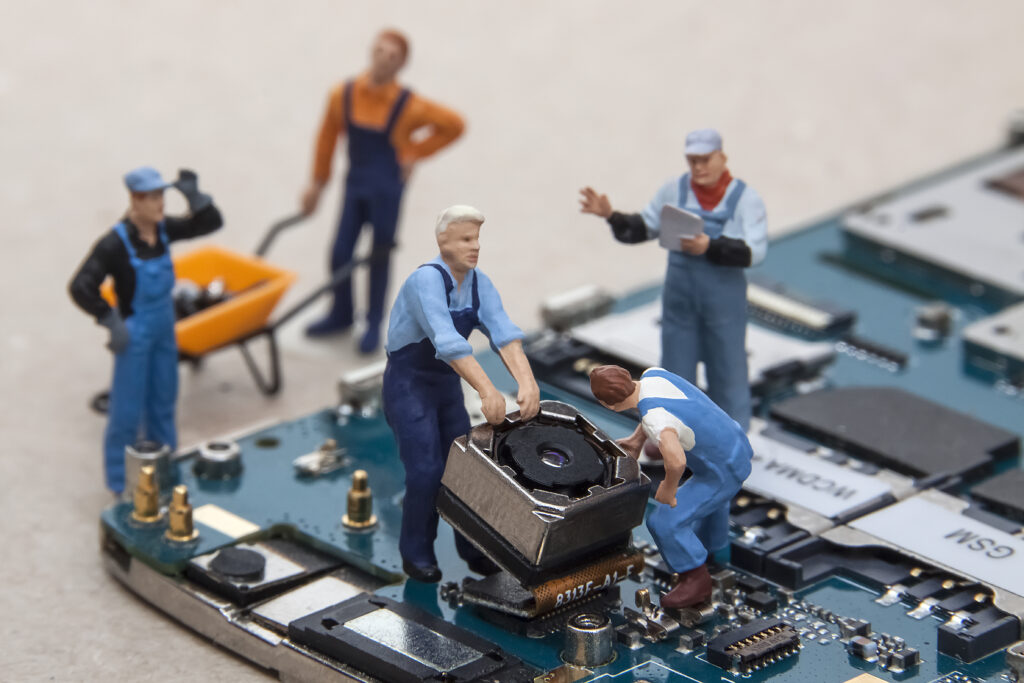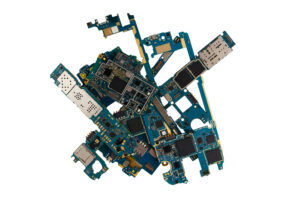Lately there have been more and more debates and discussions around the right to repair legislation, now being considered in twenty states in the US [1] .
Right-to-Repair legislation would require tech manufacturers to make diagnostics tools, repair manuals and official parts available upon request, and at a fair price.
We wanted to share our view and thoughts on this issue, how it may affect the mobile phone repair ecosystem and what should you do to get ready for it.
The Massachusetts Motor Vehicle Owners’ Right to Repair Act [2] of 2012 paved the way for a broader discussion on the right to repair beyond the automobile industry. The discussion today starts with tractors and farming equipment and goes all the way to mobile phones and other consumer electronics.
Major players are on both ends of the rope
Major players take stake on both sides of the argument and names such as Apple, uBreakiFix, iFixit, Allstate and others are either promoting or trying to stop the legislation. The repair.org association is actively working on promoting the legislation and tries to get both corporate participation and consumers’ awareness.
Such a bill recently failed to pass in Ontario, Canada [3] after a big tech company lobbied against it, which points out the significance of such legislation and the change in business it will create for these companies. Today, there are twenty states in the US, including California, where Right to Repair legislation is being considered and it appears to be a matter of time before it passes in one of them.
Some OEMs already started making their tools more available; Motorola being the first to sell DIY repair kits [4] directly to customers. We will probably see changes like this in the near future, regardless of the legislation, coming from OEMs that have smaller market share, trying to win consumers’ hearts.

How will this affect the smaller repair shops
The mom and pop repair shops and even the smaller chains does not have official access to any OEM tools or spare parts, unless publicly available (and they’re not). As a result, they can only provide repair services with unofficial spare parts and tools (and sometimes pirated software!). Any unofficial repair with non-original parts voids the warranty, so that even if the prices offered by those repair shops are low, one who sends his device for repair risks his existing warranty. As a result, it could only make sense to repair your device there if it is already out of warranty. Even when out of warranty, if you wanted to buy a certified/original part, e.g. an original battery, you couldn’t, and that usually means you are getting a lower grade replacement part which may substantially affect the mobile device’s performance.
Such legislation will allow the smaller repair shops to offer more and better repair services, without voiding the warranty and allow the customer to decide whether they’d like to use original or non-original parts. However, this creates a risk that such smaller repair shops, which are not certified or supervised, will not be transparent to the customer or will not have the required expertise. The customer may end up with a device that is not properly fixed or even dangerous.
The insurance realm
 Mobile phone insurance has become an important part of the mobile devices’ life.
Mobile phone insurance has become an important part of the mobile devices’ life.
Mobile devices are expensive, have fragile components that tend to break when they hit the floor and are an everyday work and social tool that we just can’t take our hands (and eyes) off.
2019 saw a lot of action with mobile device insurers partnering and buying mobile repair shops, which makes a very clear statement. Allstate bought iCracked in February 2019 [5], and Asurion bought uBreakiFix in August 2019 [6], creating a world in which the insurers has even more interest in making phone repair cheaper and widely available. The repair is no longer a singular event but has been converted to a subscription service.
It is no surprise that both insurers mentioned above joined the Right to Repair movement, one way or another.
Mobile device insurance is a core business for the insurance corporations. They are looking into making a better proposition to their customers while lowering costs. Better proposition comes in the form of availability and ease of repair (hence the repair shop presence), and cutting costs of labor and parts (hence the right to repair). A key factor that will enable those giants to stay competitive and improve on operational costs is software automation. Software automation starts from the end user (with an app), goes through the retail (with repair avoidance and OEM tool automation) and continues to the logistics centers (with back of house automation tools). All these solutions will allow to keep control over the big number of stores and logistics locations and keep relatively cheap staff that are professionals, just due to having a software that knows what to do all across the business.
Carriers are left behind, again
Globally, many carriers have outsourced their repair service to the likes of uBreakiFix. This had a very good impact on the financial bottom line, but created a reality in which customers are even less ‘attached’ to their provider and there is no value add or control of the carrier in the repair cycle. With insurers starting to provide more and more services directly to the customers, carriers will only be able to bundle those services with others they have, without any competitive edge or control over it. The repair business is not just about repair, though. When a device is broken it is an opportunity for an upgrade, and now the repair shops (and the insurers) are the ones to exercise on it. It is not just a loss in sales of new devices for the carrier, but a real dangerous time in the lifecycle of a customer, where churn is lurking. Subscribers are more prone to replacing their service provider when upgrading to a new device. Stats show that new smartphone purchases account to more than 50% of all changes that customers make on their mobile service plans [7].
To regain control over the customer (and device) lifecycle carriers will have to be innovative and use technology to create an omni-channel, end to end exciting and valuable experience for the subscriber.
Will it be cheaper for the consumer?
However this legislation turns, we will see a change in the structure and pricing as the insurers and big repairers are already changing the market. We should expect better and cheaper spare parts and generally a better level of service and availability of it. The fact that smartphone owners keep their device longer and longer, with 25% holding their device for more than three years before upgrading [8] already created a very active non-OEM controlled market for spare parts. The legislation will make it easier and more affordable for the smaller player to enter the ‘official’ repair market and will surely result in price drops for the parts and services rendered.
The urgent need for software tools
The legislation, if it passes, will add velocity to a change that has already started to happen. Everyone wants to service and repair everything. True, limited access to manuals and spare parts is a barrier, but when this barrier is broken, will it be enough? Today, every major smartphone OEM has a mix of one or two data and diagnostics portals, many different on-device and PC based tools, one or two software flashing tools and a few sets of physical tools.
Any repair shop who wishes to handle the plethora of devices from different OEMs would have to be proficient in the various diagnostics and service applications, how to operate them and how to make them work together from an IT perspective on the same service computer.
Surprise, these tools are not designed to coexist with other OEM tools, sometimes not even from the same OEM. None of the tools are good enough for a multi-OEM repair store environment. In addition, the existing OEM tools are not suitable for mass distribution, as they were designed for limited, targeted deployment in controlled environments.
Liran Weiss, co-founder at mce said:
The diversity and complexity of hardware and software repair for mobile devices should be addressed with software automation. This will dissolve the OEMs’ fear of losing control while allowing the smaller players to provide a competitive service. The bigger players will be able to be more agile and productive by adopting a multi-OEM repair software suite.
The legislation will require the OEMs to make new tools available for the repair service providers. Developing it will be a bottleneck and a major cost center for the device OEMs which are traditionally not focused in the support software (most OEMs outsource their support software). Furthermore, they have all limited their investment to tools supporting only the official repair facilities which will no longer be the case.
This raises the need for a multi-OEM solution that is both simple, unified in terms of operation and delivers the level of service provided by the OEM tools. Such tools should not work only to the satisfaction of the repairers but also to create the transparency and control that the OEMs are seeking not to lose.
The repairers, and subsequently the community, will benefit from lowering costs due to automation, compliance and reduced training costs. A key element is also the control over Data and Analytics and the ability to act upon insights. Without a multi-OEM tool, the repairer will have a hard time evaluating the real costs associated with the repair of different devices. Data that can and should be used to optimize and properly price its services. In addition, accurate repair (and repair avoidance) information is indicative of trends in upgrades and the time people hold their smartphone. Such data can be utilized to offer the right solution at the right time, e.g. offer to replace to a new smartphone and not repair it, not only in lieu of high repair costs.
Summary
A holistic approach to the Right to Repair legislation and movement should look on the benefits of the entire industry.
Just like Apple which is making a transition to being a services company rather than a hardware provider [9] , everyone in the industry should be pragmatic and get ready for a future (in reality, this is already the present) in which hardware upgrades are not the main event anymore. As painful as it may be for the OEMs, there is an opportunity here to secure the control over the device lifecycle and assure that the hardware quality remains high even after a repair somewhere out there. The companies that will choose to invest in software automation and data tools will benefit from the global change and from such legislation, if and when it becomes a law. When done correctly, it will allow the consumers to be happier and spend their extra dollars on services, OEMs to retain control over their loyal customers, insurers to prosper and carriers to use the eco system to reclaim their position as the all-in-one-glue to the customer.
Sources:
https://www.ifixit.com/News/california-right-to-repair-in-2019
https://en.wikipedia.org/wiki/Motor_Vehicle_Owners%27_Right_to_Repair_Act
https://www.intego.com/mac-security-blog/apple-solidifies-its-transition-to-a-services-company/
About MCE Systems:
MCE Systems is the pioneer in mobile device lifecycle management, having created more than $2.5B of shareholder value for operators and their partners since 2005. MCE’s industry-leading solutions simplify operations, increase revenues, and decrease inefficiencies. Specific solutions range from device diagnostics and care to trade-in management with a price guarantee to handling device returns. All are omnichannel-ready with world-class virtualization and provide fully integrated data management to anticipate customer needs around device-related customers issues (e.g., device health, upgrade timing). Over its more than 15 years of experience, MCE Systems has become the trusted solution to Tier-1 operators and their partners. For more information, please visit:www.mce.systems.
Follow us on LinkedIn at https://www.linkedin.com/company/mce-systems
Visit our Facebook page at https://www.facebook.com/mceSystems
Media contact:
Email:[email protected]
Company contact:
Email:[email protected]



